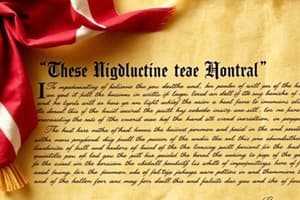Podcast
Questions and Answers
What was John Locke's influence on the Declaration of Independence?
What was John Locke's influence on the Declaration of Independence?
John Locke provided the idea of a government by the people for the people. He also believed in equality, government control, and safety.
Why was the Declaration of Independence written?
Why was the Declaration of Independence written?
The United States did not wish to be in relation to Britain in any shape or form.
List five abilities the Declaration of Independence gave the USA.
List five abilities the Declaration of Independence gave the USA.
Coin money, declare war, make treaties, make peace, form financial agreements.
What were five issues of the Articles of Confederation?
What were five issues of the Articles of Confederation?
Which state came up with The Great Compromise?
Which state came up with The Great Compromise?
What did The Great Compromise call for?
What did The Great Compromise call for?
What is the legislative branch?
What is the legislative branch?
What is the executive branch?
What is the executive branch?
What is the judicial branch?
What is the judicial branch?
What are Checks and Balances?
What are Checks and Balances?
What was Shay's Rebellion?
What was Shay's Rebellion?
What was the Great Compromise?
What was the Great Compromise?
What is the Three-Fifths Compromise?
What is the Three-Fifths Compromise?
What is federalism?
What is federalism?
What is the Electoral College?
What is the Electoral College?
Who was the Declaration of Independence written to?
Who was the Declaration of Independence written to?
What is a right that is given to people in the Declaration of Independence?
What is a right that is given to people in the Declaration of Independence?
What are American political ideals?
What are American political ideals?
What are some American values?
What are some American values?
What are American social ideals?
What are American social ideals?
What are American economic ideals?
What are American economic ideals?
What was Thomas Paine's contribution to American independence?
What was Thomas Paine's contribution to American independence?
What is the timeline of key events related to the Declaration of Independence?
What is the timeline of key events related to the Declaration of Independence?
What were the challenges of creating a new government?
What were the challenges of creating a new government?
What was the purpose of the Constitution?
What was the purpose of the Constitution?
Flashcards are hidden until you start studying
Study Notes
John Locke's Influence
- Advocated for government by the people, emphasizing equality and safety.
- Established foundational ideas for democratic governance.
Purpose of the Declaration of Independence
- Written to sever all ties with Britain, asserting complete independence.
Powers Granted by the Declaration of Independence
- Allowed the United States to coin money, declare war, make treaties, establish peace, and form financial agreements.
Issues with the Articles of Confederation
- Faced challenges such as lack of an army, inability to collect taxes, uneven power distribution, and a requirement for unanimous state consent for decisions.
The Great Compromise
- Proposed by Connecticut, establishing a bicameral legislature with equal representation in one house and population-based representation in the other.
Legislative Branch
- Responsible for the creation of laws in the government structure.
Executive Branch
- Carries out and enforces laws enacted by the legislative branch.
Judicial Branch
- Interprets laws and ensures they are applied fairly.
Checks and Balances
- A system designed to prevent any one branch of government from overpowering the others, promoting accountability and fairness.
Shay's Rebellion
- A revolt led by Daniel Shays protesting against oppressive tax burdens on farmers.
Three-Fifths Compromise
- Determined that three-fifths of a state's slave population would be counted for representation purposes.
Federalism
- Concept promoting a union of self-governing entities, balancing power between state and national governments.
Electoral College
- A group appointed by each state responsible for electing the president and vice president.
Audience of the Declaration
- Addressed to the "Supreme judge of the world," asserting moral justification for independence.
Rights in the Declaration
- States the inherent right of the people to abolish an unjust government.
American Political Ideals
- Encompasses aspects of leadership, political competition, and governance principles.
American Values
- Central values include independence, patriotism, and diversity.
American Social Ideals
- Focuses on the significance of community, culture, and religious freedom.
American Economic Ideals
- Revolves around concepts of currency, labor, trade, and market operations.
Thomas Paine's Contribution
- Advocated for John Locke's philosophies and authored "Common Sense," promoting independence.
Timeline of Key Events
- Declaration adopted in 1776, followed by the Revolutionary War (1776-1781) and the Treaty of Paris in 1783, leading to the establishment of a new government.
Challenges in Government Formation
- Key challenges included achieving broad consensus, ensuring stability, defining roles, garnering support, managing finances, and determining governmental structure.
Constitution Overview
- The Constitutional Convention culminated in 1787; the Constitution includes a Preamble and seven Articles, without an initial Bill of Rights.
Purpose of the Constitution
- Establishes legitimacy, outlines government structure, divides power, and provides a framework for change through amendments.
Studying That Suits You
Use AI to generate personalized quizzes and flashcards to suit your learning preferences.




